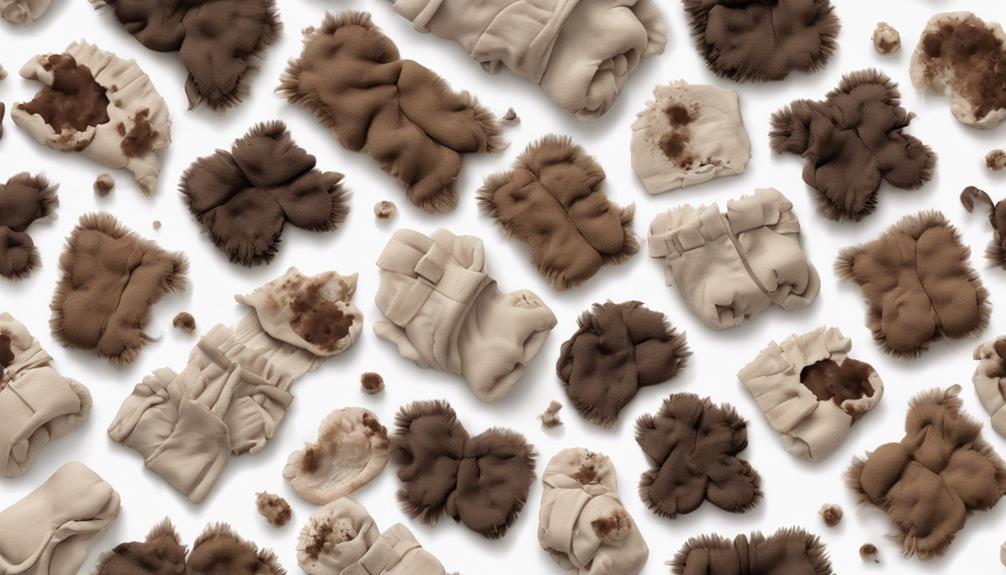Have you ever questioned why newborns have yellow seedy stool?
The color and texture of a baby's stool can reveal a lot about their health.
Understanding the nuances of what's considered normal can provide valuable insights into your baby's well-being.
So, let's explore the fascinating world of yellow seedy poop in newborns and unravel the mysteries behind this common phenomenon.
Key Takeaways
- Yellow seedy poop signifies healthy digestion and nutrient absorption in newborns.
- Presence of undigested milk curds assures parents of adequate breast milk intake.
- Monitoring frequency and consistency helps assess digestive health effectively.
- Changes in color or consistency warrant prompt medical attention for evaluation.
Characteristics of Yellow Seedy Poop
The appearance of yellow seedy poop in newborns is a reassuring sign of healthy digestion and nutrient absorption. This type of stool is commonly observed in breastfed infants and is primarily attributed to the breakdown of bilirubin in the baby's digestive system. The yellow hue of the poop is a result of this process.
Additionally, the seedy texture of the stool can be explained by the presence of undigested milk curds, which are a normal component of breast milk. Parents should find comfort in the sight of yellow seedy poop as it indicates that the baby is receiving adequate breast milk and that their digestive system is functioning effectively.
Understanding these characteristics can help caregivers feel more confident about the baby's well-being and nutritional intake. It's essential to recognize that this type of poop is a positive indication of the newborn's health and shouldn't be a cause for concern.
Causes of Yellow Seedy Poop

Observing the yellow seedy poop in newborns can be attributed to the breakdown of bilirubin in their digestive system, a process that results in the characteristic color and texture of their stool. Breastfed babies often display this type of stool due to the high fat content in breast milk. The seedy texture is a consequence of undigested milk curds present in the stool. Yellow seedy poop is a positive indicator that the baby is receiving adequate breast milk and is effectively digesting it. This healthy stool color signifies proper digestion and nutrient absorption. Below is a table summarizing the causes of yellow seedy poop in newborns:
| Causes of Yellow Seedy Poop |
|---|
| Bilirubin breakdown |
| High fat content in breast milk |
| Undigested milk curds |
Understanding these factors can reassure parents that their newborn is thriving and receiving the necessary nutrition for healthy development.
Normalcy of Yellow Seedy Poop
Noticing the yellow seedy poop in newborns signifies their digestive system is functioning effectively, highlighting the normalcy of this stool color. In breastfed babies, this yellow hue is a result of the breakdown of bilirubin in the liver, giving the poop a mustard-like appearance. The seedy texture seen in newborn poop is often due to undigested milk fats, which is a common occurrence in babies fed with breast milk. It's completely normal for parents to observe yellow seedy poop in their newborn's diapers multiple times a day.
As babies grow and their digestive system matures, changes in the consistency and color of yellow seedy poop may occur. These variations are typically part of the natural progression as the baby's gut adapts to processing breast milk efficiently. Therefore, the presence of yellow seedy poop in newborns should be viewed as a reassuring sign of their developing digestive health and the normalcy of their bowel movements.
Monitoring Yellow Seedy Poop
When checking newborns' stools, we can assess the health of their digestive system by monitoring the frequency and consistency of their yellow seedy poop. The presence of this type of stool indicates that the baby is effectively digesting breast milk and absorbing essential nutrients. A regular occurrence of bright yellow, sweet-smelling, seedy poop suggests that the baby is receiving adequate milk and that their digestive system is functioning at its best. To track the baby's digestive health, parents can use the following table as a guide:
| Frequency | Consistency | Color |
|---|---|---|
| 3-4 times a day | Seedy texture | Bright yellow |
| Variable | May contain undigested milk fat | Sweet smell |
Seeking Medical Advice
Should your newborn's yellow seedy poop display persistent watery consistency or color changes, prompt medical consultation is advised. Consulting a healthcare provider is important if your baby's yellow seedy poop is accompanied by signs of dehydration or fever.
Changes in the consistency or frequency of yellow seedy poop may indicate an underlying issue that requires professional evaluation. It's important to communicate any concerns about your newborn's yellow seedy poop with a pediatrician for proper assessment and guidance.
Seeking medical advice for unusual changes in your baby's yellow seedy poop can help guarantee early detection and management of any potential health issues. Remember, caregivers play a crucial role in observing and reporting any deviations from the norm in a newborn's bowel movements.
Early intervention through professional evaluation can prevent complications and provide necessary support for both the baby and the family. Trust your instincts and seek medical advice promptly for the best possible care.
Frequently Asked Questions
What Does Seedy Poop Mean in a Newborn?
Seedy poop in a newborn signifies effective digestion and nutrient absorption. The seedy texture results from undigested milk fat particles, a common occurrence in breastfed babies. Yellow seedy poop is a healthy sign of a well-functioning digestive system.
When Does Baby Poop Stop Looking Seedy?
We observe the shift from seedy poop to smoother consistency typically occurs around 4 to 6 weeks of age in breastfed babies. This change reflects their digestive system's maturation, signaling a step in their growth.
What Looks Like Little Seeds in Newborn Poop?
We notice little seeds in newborn poop, which are undigested milk curds. This common sight in breastfed babies indicates a healthy digestive system. The seedy appearance shows effective breast milk digestion, assuring proper nutrition.
What Does Milk Allergy Poop Look Like?
When a newborn has a milk allergy, their poop may be green or yellow, frothy, and smelly with mucus. Blood streaks may also show up. If you notice these signs, consult a pediatrician promptly for guidance.
Conclusion
To sum up, yellow seedy poop in newborns is a normal and healthy occurrence for breastfed babies. It's a sign of the baby's digestive system processing breast milk efficiently.
On average, breastfed babies may have up to 8-10 bowel movements a day during the first few weeks of life.
Monitoring your baby's poop and consulting with a pediatrician if you have any concerns is important for ensuring their overall health and well-being.










